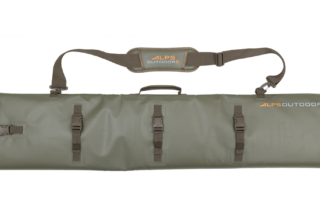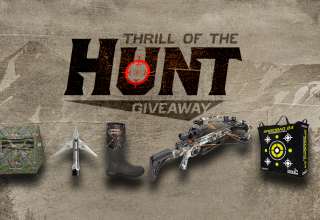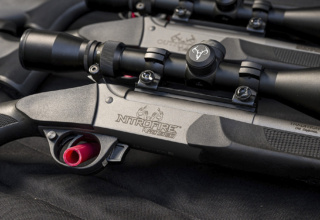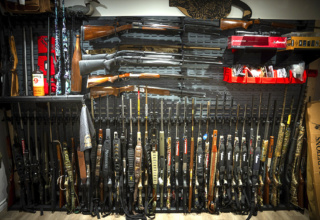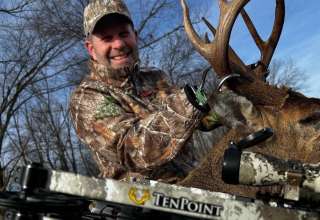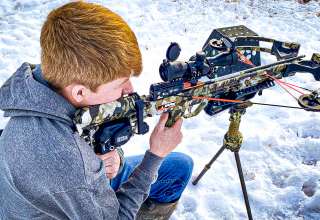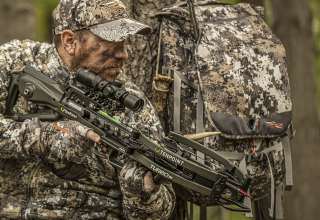There are good reasons to hunt turkeys with a crossbow. Here’s what you need to know…
by Brad Fenson
The truck was parked behind a hill to ensure it didn’t change the daily routine of the local turkey flock. Stumbling down a well-used cow trail, my hunting partner and I lugged a blind, chairs, and my TenPoint crossbow for a morning hunt. If things went according to plan, the turkeys would leave their roost and slowly wander and feed in our direction.
We set up in a long, narrow hay field surrounded by brush that had been thinned by grazing cattle. The grassy lane we targeted looked like a runway for local aircraft but served as a boardwalk for strutting toms. The birds could leave the roost in several directions, usually showing up on the grass strip to congregate and display before dispersing farther afield.
Hot coffee steamed from our Thermos bottle as the aroma of the dark brew wafted through the air. I swear the turkeys got a whiff of the morning beverage, as distinct gobbles started to erupt from the tall hardwoods. I released the ACUslide on my Vapor RS470 and slid it down the rail and attached it to the string. Silently, I cranked the slide back up the rail to cock the string in place and ready my bow for the hunt. I shouldered my crossbow and checked the limb clearance against the blind and in the shooting windows. I moved my chair back a couple of inches to increase clearance out of the windows where I anticipated a shot.
The sound of turkeys in the cool air is always exciting, and the clucks, putts, and gobbles were beacons to keep track of the advancing birds. The sun was starting to peek through the trees at the far end of our field when the first birds stepped into view. Within minutes, more birds showed up on the ridge in front of us and worked down through the trees. The gobblers were in fine form, showing off their feathers and wide array of colors.
It is hard to beat a good turkey show, having all the aspects of a soap opera in nature. Fights, love affairs, fine dining, and social behavior are some of the reasons hunters get up at ridiculous hours of the morning to catch of glimpse of North America’s largest upland bird.
I raised my binocular to look over a group of longbeards headed in our direction. The hens were headed in our direction, and the toms were close behind. The fanned-out quartet of performers were closing the distance fast and I picked the bird with a thick, heavy beard to target. I had already ranged the area the birds were strutting through, and when my target bird stepped down from his strutting position, I leveled my crosshair on its vitals. The sound of the arrow launching off the rail didn’t spook the birds, but the whack of my broadhead breaking bone and traveling through the big turkey turned heads.
I had just taken my first tom with the Vapor RS470 and watched the other birds head down the boardwalk as those on the far end continued to strut and do what turkeys do.
Why a Crossbow?
To start, the quiet release of an arrow to harvest a spring gobbler will help sustain hunting opportunities on your property. The boom of a shotgun can send birds halfway across the county, meaning you have nothing to hunt in the days that follow. With a crossbow, there is less noise and disturbance, meaning you can manage your birds and your hunting opportunities by ensuring they stay on the ground where you have permission to hunt.
A modern crossbow provides the speed and accuracy to harvest a turkey efficiently and is a great tool for everyone from the novice to the seasoned hunter. It isn’t unusual to be hunting with a friend or family member and shoot two birds out of the same flock.
The Vapor RS470 generates incredible speed and offers a cushion for ranging exact distances before you shoot. Movement is a critical component to success, and when you don’t have to continually range birds, your success rate goes up.
Use the Right Equipment
Thousands of feathers cover a turkey, providing everything from protection to a tailored uniform for breeding. The base of each feather has a quill, where the feather gets blood supply to grow. Quills are like a drinking straw but heavier in structure, much like a human fingernail. When you line up layers of large hollow bones, quills, and feathers, you have the makings for the best arrow stopper ever made. Avid archers know it is easier to get a clean pass-through on a deer than it can be on a turkey.
There are always questions about fixed versus mechanical blades for turkeys, but when you find one that works, stick with it. The SEVR Titanium 2.1 is my confidence broadhead, offering the best of all worlds. The Lock-and-Pivot blades swivel as needed to keep the arrow driving straight through a turkey, even when large quills and bone are contacted. Using the provided set screw, you can lock the blades in place to practice with the head you intend to hunt with, ensuring accuracy and known trajectory. With a cutting diameter greater than two inches, it is easier to catch the spine and ensure the bird never leaves your sight. The best part about SEVR is you can purchase them one at a time, meaning you aren’t storing extra broadheads for future turkey hunting.
Shot Options
The wing shot has always been touted as the best option to kill a turkey with archery equipment. Unfortunately, there are large bones and layers of dense wing feathers and quills to penetrate for this shot.
More archers are talking about shooting a bird head-on or standing facing directly away, allowing you to visualize where the spine is located. With a two-inch cutting diameter, it is easier to take a bird out with a clean killing shot through the backbone. Feathers and quills on the breast and back are much smaller than in the wing area. The facing or straight-away shot also takes out the lungs and possibly the backbone with good penetration or a pass-through.
The Delta McKenzie Strutter or Alert Turkey Decoy is a great way to practice and ensure your arrow finds the kill zone on a bird. The lungs on a turkey are located high in the back, along the spine, meaning you must shoot for the upper couple inches of the bird on profile. The breast is solid muscle, and the white meat is delicious but offers little blood flow for a killing shot. A low-placed arrow is problematic on a big turkey, so know where to aim.
Beef it Up
An easy thing you can do to increase your odds of a quick kill on a big strutter is to use a heavier broadhead and arrow combination. A 125-grain head will pack much more punch, transfer more energy from your bow to your arrow, and optimize penetration.
You can also beef up your arrows and shoot an Easton Full Metal Jacket (FMJ) with brass inserts. And, before you start complaining about arrow drop and trajectory, consider that most turkeys are shot at less than 30 yards. Close range targets help maintain flat trajectories, and sighting in a heavier broadhead and arrow for busting through turkeys is simple, smart, and strategic. Increased kinetic energy makes short work of hollow bones and feathers, and the aluminum shaft provides better viscosity for deeper penetration.
Comfort for the Win
Blinds are great for setting up for local turkeys. Staying comfortable is critical to success when the days are long and paying attention to details makes a big difference when opportunity knocks or, in some cases, gobbles. The ALPS OutdoorZ Stealth Hunter Chair is fully adjustable, allowing you to set up to not only be comfortable but also to ensure you can see and shoot clearly out the shooting windows. Being at the right height will ensure you aren’t torquing the bow and straining to try and make a shot angle. With wide feet and adjustments for height and level, the chair is worth its weight in turkey meat.
Use a crossbow for your next turkey hunt and stack the odds in your favor by customizing your equipment and practicing for a quick, clean kill.










